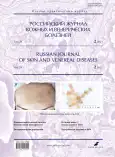Methods of camouflage vitiligo (literature review)
- Authors: Vovdenko K.A.1, Lecaillon M.1, Lomonosov K.M.1
-
Affiliations:
- I.M. Sechenov First Moscow State Medical University
- Issue: Vol 24, No 2 (2021)
- Pages: 161-166
- Section: DERMATOLOGY
- URL: https://journal-vniispk.ru/1560-9588/article/view/63945
- DOI: https://doi.org/10.17816/dv63945
- ID: 63945
Cite item
Abstract
Vitiligo significantly affects the quality of life of patients, their social and psychological adaptation in society. It has been noted that patients with vitiligo are more likely to develop anxiety and depressive disorders, suicidal thoughts. Standard therapy regimens today often take a long time, are not enough effective and do not always meet the expectations of the patient and the dermatologist, reduces compliance to treatment. In this regard, comprehensive therapy for vitiligo remains a pressing issue to this day.
Medical camouflage is a promising adjunctive or alternative therapy for vitiligo, as it allows to control the clinical manifestations of the disease.
The purpose of this review is to consider the main types of medical camouflage in the Russian and foreign markets, their availability and principles of action. The PubMed database and the Internet were used to identify the most effective, affordable, and easy-to-use products available in the Russian and foreign markets. The research identified the most significant products that are most convenient to apply to the skin and are easily available for purchase by vitiligo patients in Russia. Parameters such as shape, texture, composition and effect duration were evaluated. Each group of preparations was described in detail, as well as the technique for their correct application.
Thus, this review will be useful to all practicing dermatologists in controlling the clinical course of vitiligo as well as its skin manifestations.
Keywords
Full Text
##article.viewOnOriginalSite##About the authors
Kseniia A. Vovdenko
I.M. Sechenov First Moscow State Medical University
Author for correspondence.
Email: Vovdenkoksenia@ya.ru
ORCID iD: 0000-0003-1415-3940
SPIN-code: 8315-2175
Postgraduate student of the Department of Skin and Venereal Diseases
Russian Federation, 8 buil. 2 Trubetskaya street, 119991 MoscowMakhabbat Lecaillon
I.M. Sechenov First Moscow State Medical University
Email: askmaha@mail.ru
ORCID iD: 0000-0003-4767-3002
Postgraduate student of the Department of Skin and Venereal Diseases
Russian Federation, 8 buil. 2 Trubetskaya street, 119991 MoscowKonstantin M. Lomonosov
I.M. Sechenov First Moscow State Medical University
Email: lamclinic@yandex.ru
ORCID iD: 0000-0002-4580-6193
SPIN-code: 4784-9730
Doctor of Medical Sciences, Professor of the Department of Skin and Venereal Diseases
Russian Federation, 8 buil. 2 Trubetskaya street, 119991 MoscowReferences
- Taieb A, Picardo M. Definitions and classification. In: Taieb A, Picardo M, eds. Vitiligo. Berlin, Heidelberg: Springer; 2019. P. 11–23. doi: 10.1007/978-3-319-62960-5
- Zhang XJ, Liu JB, Gui GP, et al. Characteristics of genetic epidemiology and genetic models for vitiligo. J Am Acad Dermatol. 2004;51(3):383–390. doi: 10.1016/j.jaad.2003.12.044
- Braun-Falco O, Plewig G, Wolf HH. Dermatologie und Venerologie, 4. Aufl., Depigmentierungen. Berlin, Heidelberg, New York: Springer; 1996. 931 р.
- De Gruyter W. Pschyrembel Klinisches Wörterbuch (259, neu bearbeitete Auflage) Berlin: Walter de Gruyter Gmbh & Co. KG; 2002.
- Silverberg JI, Silverberg NB. Association between vitiligo extent and distribution and quality-of-life impairment. JAMA Dermatol. 2013;149(2):159–164. doi: 10.1001/jamadermatol.2013.927
- Porter J, Beuf AH, Nordlund JJ, Lerner AB. Psychological reaction to chronic skin disorders: a study of patients with vitiligo. Gen Hosp Psychiatry. 1979;1(1):73–77. doi: 10.1016/0163-8343(79)90081-1
- Porter J, Beuf AH, Lerner A, Nordlund J. Response to cosmetic disfigurement: patients with vitiligo. Cutis. 1987;39(6):493–494. doi: 10.1016/0163-8343(79)90081-1
- Porter JR, Beuf AH, Lerner AB, Nordlund JJ. The effect of vitiligo on sexual relationships. J Am Acad Dermatol. 1990;22(2 Pt 1):221–222. doi: 10.1016/0190-9622(90)70028-G
- Pahwa P, Mehta M, Khaitan BK, et al. The psychosocial impact of vitiligo in Indian patients. Ind J Derm Venereol Leprology. 2013;79(5):679–685. doi: 10.4103/0378-6323.116737
- Ongenae K, Beelaert L, van Geel N, Naeyaert JM. Psychosocial effects of vitiligo. J Eur Acad Dermatol Venereol. 2006;20(1):1–8. doi: 10.1111/j.1468-3083.2005.01369.x
- Sarkar S, Sarkar T, Sarkar A, Das S. Vitiligo and psychiatric morbidity: a profile from a vitiligo clinic of a rural-based tertiary care center of eastern India. Ind J Dermatol. 2018;63(4):281–284. doi: 10.4103/ijd.IJD_142_18
- Lai YC, Yew YW, Kennedy C, Schwartz RA. Vitiligo and depression: a systematic review and meta-analysis of observational studies. Br J Dermatol. 2017;177(3):708–718. doi: 10.1111/bjd.15199
- Tanioka M, Yamamoto Y, Kato M, Miyachi Y. Camouflage for patients with vitiligo vulgaris improved their quality of life. J Cosmet Dermatol. 2010;9:72–75. doi: 10.1111/j.1473-2165.2010.00479.x
- Taieb A, Alomar A, Böhm M, et al. Guidelines for the management of vitiligo: the European Dermatology Forum consensus. Br J Dermatol. 2013;168(1):5–19. doi: 10.1111/j.1365-2133.2012.11197.x
- Cabrera R, Hojman L, Recule F, et al. Predictive model for response rate to narrowband ultraviolet B phototherapy in vitiligo: a retrospective cohort study of 579 patients. Acta Derm Venereol. 2018;98(3-4):416–420. doi: 10.2340/00015555-2889
- Bae JM, Jung HM, Hong BY, et al. Phototherapy for vitiligo: a systematic review and meta-analysis. JAMA Dermatol. 2017;153(7):666–674. doi: 10.1001/jamadermatol.2017.0002
- De Cuyper C. Permanent makeup: indications and complications. Clin Dermatol. 2008;26(1):30–34 doi: 10.1016/j.clindermatol.2007.10.009
- Tanioka M, Yamamoto Y, Kato M, Miyachi Y. Camouflage for patients with vitiligo vulgaris improved their quality of life. J Cosmet Dermatol. 2010;9(1):72–75. doi: 10.1111/j.1473-2165.2010.00479.x
- DePase A. ‘La Voce dei Pazienti’. Evidence Based Dermatology. Milan: Masson Publisher; 2003.
- Ongenae K, Dierckxsens L, Brochez L, et al. Quality of life and stigmatization profile in a cohort of vitiligo patients and effect of the use of camouflage. Dermatology. 2005;210(4):279–285. doi: 10.1159/000084751
- Savin J. The hidden face of dermatology. Clin Exp Dermatol. 1993;18(5):393–395. doi: 10.1111/j.1365-2230.1993.tb02234.x.
Supplementary files






